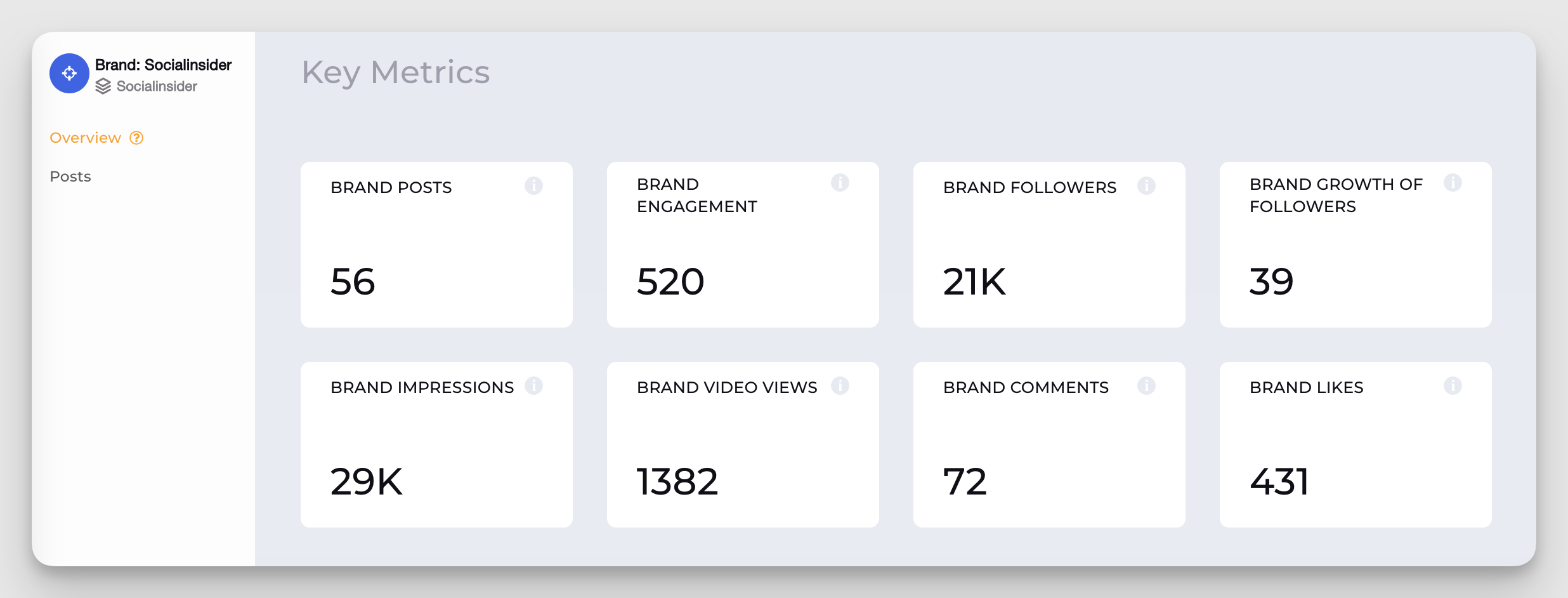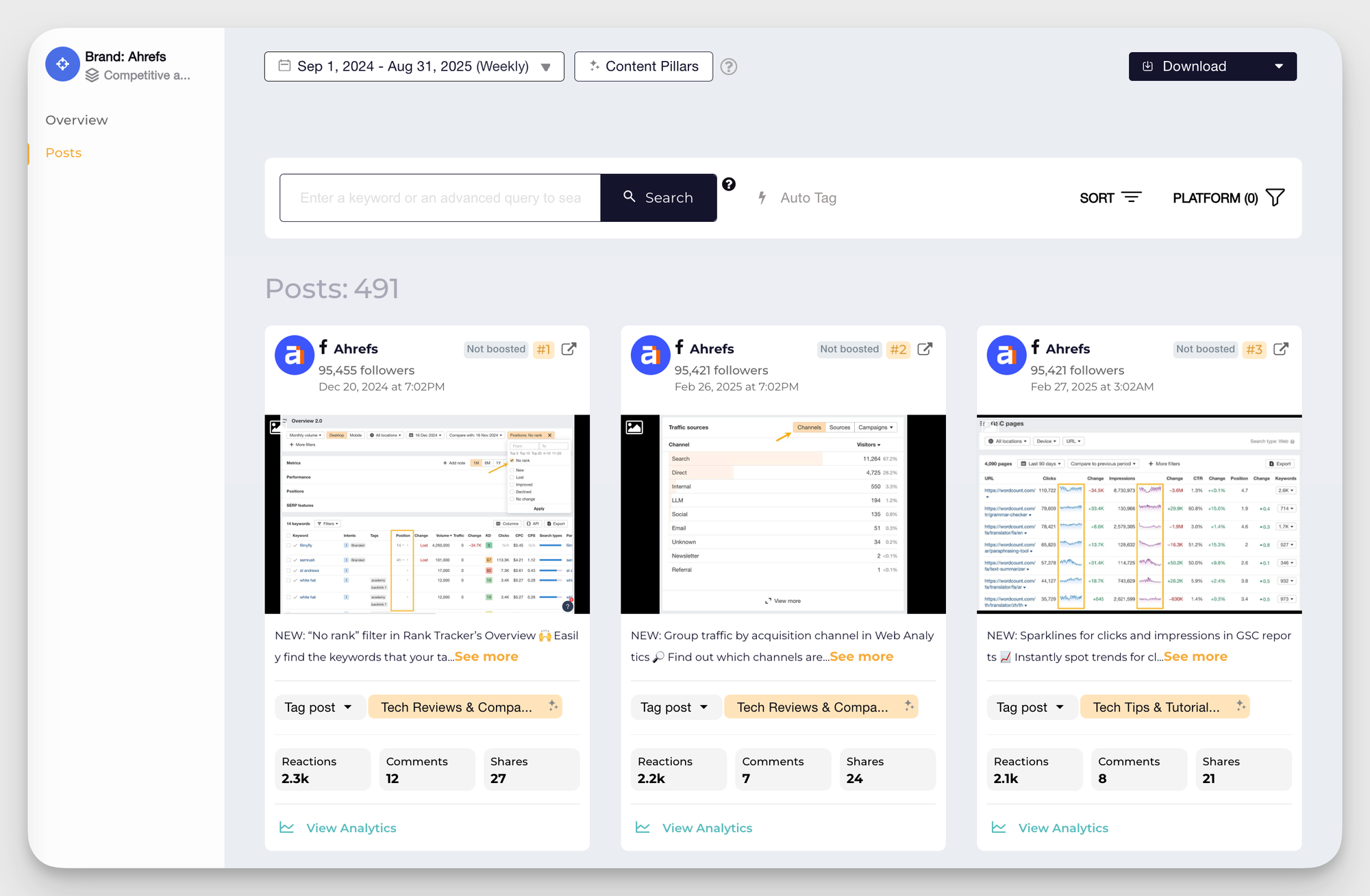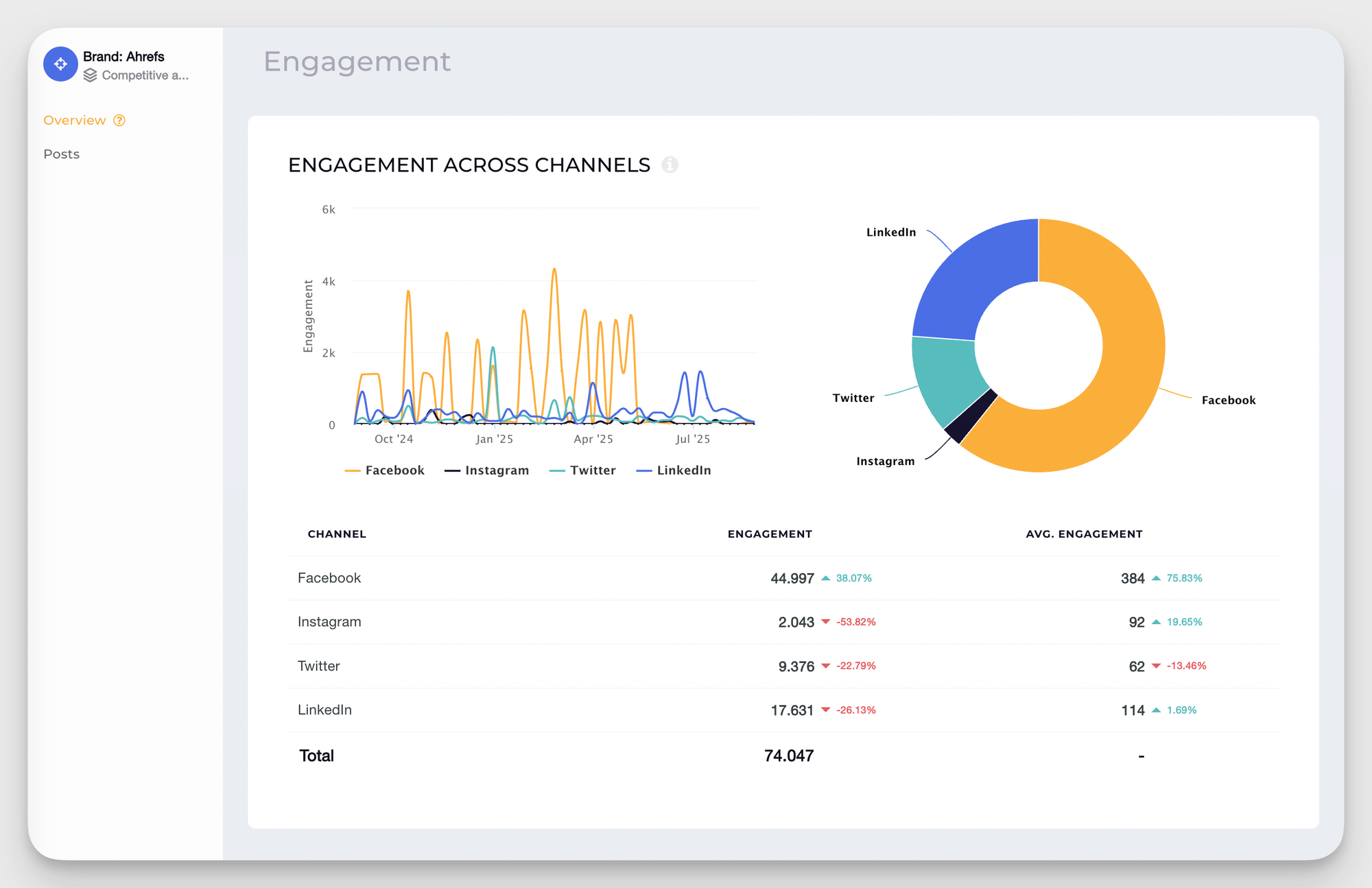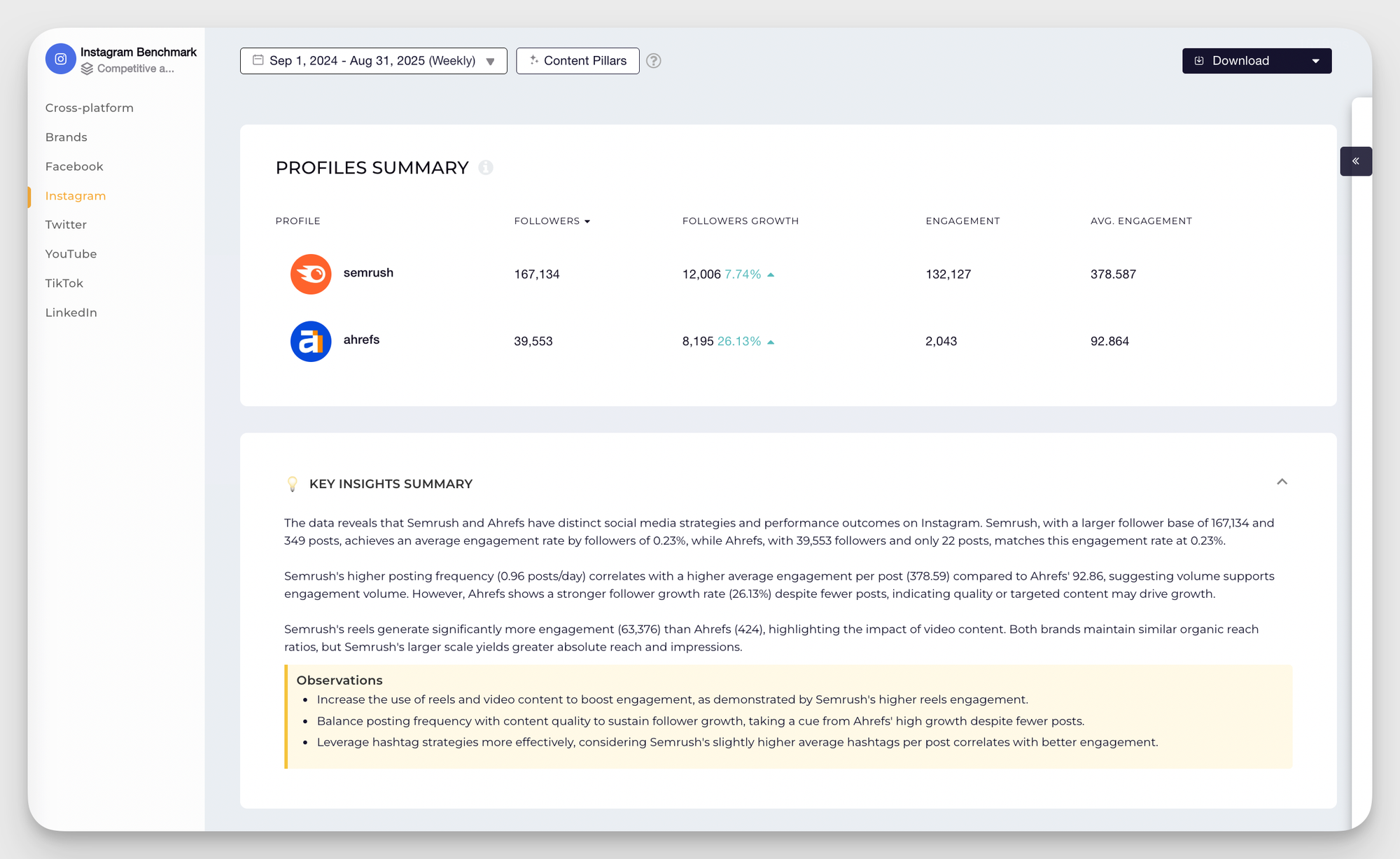Mastering Your Brand Audit: A Detailed Walkthrough
Enhance your brand's performance with a comprehensive brand audit. Identify key insights and strategies to strengthen your market position today.


Businesses often go through a brand-building exercise when starting out and then just roll with it indefinitely, only to wake up one day to the harsh reality that the brand is in crisis; that is, it doesn’t match the business anymore; that it’s inconsistent and inefficient.
To avoid that, you must do a periodic brand audit to understand strengths and weaknesses and to improve proactively, not just reactively.
If you're not sure how to do a brand audit or feel overwhelmed by the endeavor, this article will guide you through the steps, templates, and resources you need to make this process quick and painless.
Key takeaways
-
Conduct a brand audit whenever you face performance issues, market shifts, or major business changes to ensure strategies are based on facts, not assumptions.
-
Pre-audit preparation is crucial: set clear goals, define KPIs, create a checklist, and confirm the tools you’ll use before collecting data.
-
A complete brand audit examines customer feedback, sales data, website analytics, brand assets, competitor benchmarks, and internal culture.
-
The process should end with actionable recommendations, clear timelines, and regular monitoring to keep your brand aligned with customer expectations and market trends.
What is a brand audit?
The brand audit is a process by which you take inventory of brand assets, look at the brand’s performance on different channels, and conduct competitive analyses. Brand audits are a must for startups as well as for established enterprises to diagnose problems and get valuable insights for growth.
A brand audit is like a health check. Just as you see a doctor for a yearly checkup and take your car for regular oil and filter changes, you must make brand audits a part of your business routine.
Why brand audits matter?
A brand audit report will inform you about how the target audience perceives your brand and how efficient branding efforts are.
Based on the brand evaluation worksheet, you can draw valuable conclusions that help you:
- adjust brand awareness strategies;
- improve marketing campaigns;
- change business goals to remain competitive.
Without brand audits, you risk missing important clues about brand relevance and efficiency. You are also more vulnerable to communication crises and less prepared for their successful resolution.
No pressure, but…
“The way a company brands itself is everything–it will ultimately decide whether a business survives.” - Sir Richard Branson
When to conduct a brand audit?
By conducting brand audits at regular intervals, you can accurately assess if your brand still resonates with the right audiences, performs on social media as per the industry benchmarks, and supports overall business growth.
A brand audit is especially useful before making big strategic decisions. It ensures your strategies are built on accurate insights, not assumptions.
Here are some situations when running a brand audit makes the most sense:
Major business changes: You have just gone through a rebrand, merger, acquisition, or expansion into a new market.
Performance issues: Your engagement, reach, and conversion numbers have plateaued, and you can’t pinpoint the problem.
Shift in audience behavior: Customer sentiment is changing fast across all channels.
Internal scaling or restructuring: Your team has grown or restructured recently–new social media managers, agencies, or multiple regional teams.
Competitive pressure: Your competitors are regularly launching new campaigns, products, or content strategies that capture more attention.
Reputation or PR issues: There has been a steady spike in negative sentiment, poor reviews, or crisis events.
Content fatigue: Your content types (like Reels, TikToks, or carousels) are no longer performing despite consistent publishing, and there’s a clear misalignment between what you’re producing and what your audience expects.
Platform algorithm or feature changes: Social platforms have updated their algorithms or introduced new features, and your current strategy is just not able to keep up.
Pre-audit preparation
Brand audits involve collecting a lot of data, which can obviously take a lot of time. If you don’t have a structured plan in place, you will just end up collecting massive amounts of data without knowing how to actually use it.
The goal of pre-audit preparation is to ensure your audit stays focused and measurable throughout the process.
Here’s what it involves.
Set clear brand audit goals and KPIs
Your audit goals should be tied to the metrics that matter to your brand and the challenges that triggered the entire audit in the first place.
Here are some examples
Major business changes (rebrand, merger, new market entry)
- Goal: Track how effectively your updated identity is reflected across platforms and whether awareness is growing after the change/ market entry.
- KPIs: Brand mentions, follower growth, traffic from target regions
Performance issues
- Goal: Audit content performance to identify what’s underperforming and why your reach isn’t growing.
- KPIs: Engagement rate by format, reach vs. impressions, conversion rate from social media, ads, and website
Shift in audience behavior
- Goal: Assess whether your audience demographics, interests, and channel preferences are evolving.
- KPIs: Audience age/location breakdown, sentiment analysis, engagement by platform
Competitive pressure
- Goal: Benchmark your performance against direct competitors to identify gaps and opportunities.
- KPIs: Share of voice, engagement rate comparison, follower growth, content reach, and other social media benchmarks
Reputation or PR issues
- Goal: Monitor brand perception and how quickly your team responds to negative conversations.
- KPIs: Sentiment ratio (positive vs. negative mentions), response time to queries, customer satisfaction scores
Content fatigue
- Goal: Identify which content formats have plateaued, why they no longer resonate with the audience, and which new or emerging formats can drive higher engagement.
- KPIs: Engagement and reach per format (Reels vs carousels vs static posts), video completion rates, follower growth rate
Platform algorithms or feature updates
- Goal: Assess how algorithm updates or new features affect your visibility and refine your content strategy accordingly.
- KPIs: Organic reach, impressions, engagement rate before and after update, content performance by format
Define success metrics and evaluation criteria
While goals and KPIs tell you what to measure, success metrics define how you’ll be able to judge whether the results are good enough or not. Without them, you risk ending up with pretty charts that don’t help you make any business decisions.
You need to set clear benchmarks for your audit. For example, if you are auditing your brand because of performance issues, you could define success as improving engagement rate by 15% in six months.
Create your brand audit checklist and structured plan
Build a simple checklist for your audit to make sure you have got everything in place and don’t end up wasting hours chasing every single data point. A checklist can also come in handy for future audits
This can include details about
- Which aspects of your brand will you review (website, social media audit, customer experience, PR)?
- What data sources will you pull from (social, website, customer feedback, competitor tools)?
- Which tools will you use (Socialinsider, Google Analytics, SEMrush)?
- Who’s responsible for each part of the audit?
Establish a realistic time frame
Define both how long the audit will take and how often you’ll repeat it.
- Overall duration: Decide how long the audit should take, depending on the scope and resources.
- Milestones and checkpoints: Break the project into stages (data gathering, analysis, reporting) with target deadlines for each.
- Repeat cycle: Define how often the audit will be revisited–quarterly, biannually, or annually.
Identify the main tools for audit
Confirm access to your analytics platforms (Meta Business Suite, TikTok Analytics, Google Analytics), social listening tools (Brandwatch, Mention), social media analytics and benchmarking tools (Socialinsider).
You will also need a collaborative workspace like Miro for mapping audit processes, especially if multiple teams are involved.
Steps for conducting a brand audit
With all the pre-audit processes out of the way, it's now time to finally get started with your brand audit. Take a look at the steps.
Step 1: Gather data and information
This stage involves pulling accurate, unbiased data from every possible touchpoint to get a full picture of how your brand is performing across the different channels.
Here’s how you can go about it.
Collect customer feedback and reviews
Customer feedback and latest reviews can give you insights into what your customers need, what they prefer, and what they would want to avoid. By collecting direct and indirect feedback, you can spot your brand’s strengths and blind spots more accurately.
What data to collect
- Direct feedback: Surveys, Customer Satisfaction (CSAT) polls, or structured interviewsIndirect feedback: Social media comments, online reviews (G2, Capterra, Trustpilot, Google Reviews), and Reddit forum discussions.
- Inferred feedback: Customer support tickets, audience behavior, and engagement patterns on social media platforms.
What to look for
- Recurring praise points: The most common praises from your customers, which could be your product features, customer service, or even brand presence on social media.
- Common complaints: These are the most common complaints from customers, which could be crucial for the brand to fix to prevent churn and reputational damage.
- Expectation gaps: These are the gaps where your brand promises don’t fully align with the customer experience.
Compile sales data and performance metrics
You need hard numbers that reflect actual business performance. Sales and performance metrics show whether brand awareness and engagement are even leading to revenue or if they are just vanity metrics.
Here’s how you can go about it.
What data to collect
- CRM data: Pipeline health, lead response time, number of MQLs per month, win/loss rate
- Product usage data: Feature adoption, activation rates, active users
- Web analytics data: Traffic sources, conversion funnels, attribution paths
- Billing & revenue data: MRR, ARR, churn, customer lifetime value
- Social media data: Reach, engagement, and views across different channels and content pillars

What to look for
- Revenue trends: Look into year-on-year data to identify growth plateaus, seasonal spikes, or declining revenue streams.
- Customer retention and churn rates: Measure long-term customer loyalty to find out what makes customers stay or leave
- Customer acquisition cost (CAC): Calculate how much you’re spending to acquire new customers and compare it to customer lifetime value (CLV).
- Channel efficiency: Identify which sales and marketing channels deliver the highest ROI.
- Social media ROI: Analyze which content types (video, carousel, stories, blogs repurposed into posts) or content pillars drive engagement and conversions.
Gather website analytics and digital insights
It helps you assess how well your website is performing as a revenue engine for your business. You get clear visibility into how users navigate your site, which content they engage with most, and where they tend to drop off.
What data to collect
- Traffic reports: Visitor numbers, session duration, bounce rate.
- User behavior: Heatmaps, scroll depth, click-through patterns.
- Acquisition sources: Organic, paid, referral, direct, and social.
- Conversion data: Form submissions, demo requests, trial sign-ups, purchases.
- SEO performance: Rankings for target keywords, backlink profile, and content performance.
- Social media performance: Engagement metrics (likes, shares, comments, saves), impressions, video views, post-level analytics across platforms.

What to look for
- Traffic quality: Assess if visitors align with your ICP (ideal customer profile).
- Conversion bottlenecks: Identify pages with high drop-offs or low form completions.
- Keyword visibility: Measure organic presence against competitors.
- Content performance: Evaluate traffic and conversions from blogs, resources, and landing pages.
- Social media performance: Compare engagement and reach, and analyze granular post-level performance to see what formats, messages, or channels drive the strongest results.
Organize marketing materials and brand assets
You should also review how consistently your brand is represented across different customer touchpoints. The goal is to assess if your brand looks, sounds, and feels the same everywhere.
What information to collect:
- Visual identity: Logos, typography, color palette, design templates.
- Communication channels: Website, blog, email newsletters, PR mentions, ads (digital and outdoor).
- Content assets: Case studies, whitepapers, brochures, pitch decks, one-pagers.
- Social media presence: Brand assets from LinkedIn, Instagram, TikTok, Facebook, and other relevant platforms .
- Internal docs: Brand guidelines, messaging frameworks, tone of voice documents.
What to look for:
- Brand consistency: Ensure visual identity and tone align across channels.
- Message alignment: Evaluate if value propositions remain clear and relevant.
- Asset gaps: Identify missing formats (For example, no case studies for proof or no video content for awareness).
- Channel presence: Assess if your brand is active in all the places your ICP engages.
- Content freshness: Spot outdated assets or messaging that no longer match strategy.
Conduct competitor research and market data collection
The data from competitors and market research can give you external benchmarks to measure your brand’s performance against. It can help you identify gaps in your positioning, reveal opportunities where competitors may be underperforming, and show you which market trends are shaping customer expectations.
What information to collect:
- Competitor presence: Website, social media activity, ad campaigns, and PR mentions of your competitors.
- Product positioning: Value proposition, feature sets, and pricing models of your competitors.
- Market share indicators: Traffic estimates, review volumes, and brand mentions of the big players in your industry.
- Industry benchmarks: The average engagement rates and reach for your industry.
What to look for:
- Positioning gaps: Look for opportunities where your brand can differentiate its messaging from competitors..
- Feature parity: Evaluate whether competitors are outperforming or underdelivering in key product features compared to you.
- Channel dominance: Analyze which platforms your competitors are most successful on and how they leverage those channels.
- Engagement strategies: Look into the content formats your competitors prefer, along with their posting frequency.
Tools for gathering data and information
- Socialinsider for in-depth cross-platform social media analytics (historical data, post-level insights)
- SurveyMonkey for structured feedback collection
- Google Analytics for website performance insights
- Ahrefs for SEO and keyword analysis
- Similarweb for competitor and market intelligence
- Google Sheets for consolidating all findings into a single audit dashboard
- G2, Trustpilot, or Capterra for scraping third-party reviews (depending on your industry).

Step 2: Assess internal branding and culture
Internal branding hinges on whether employees understand and embody your brand or not–and it shows in how they post, engage, and represent the company online.
Here’s what you need to focus on when auditing internal branding:
Employee brand knowledge and understanding
You need to look into whether employees, especially those managing social accounts and the company website, understand the brand’s positioning, tone, and key messages. Do they know how to explain what the company does in simple terms? Are they able to clearly articulate the value proposition to a customer or partner?
Internal communication and brand messaging
Look at how brand updates (new campaigns, product launches, tone of voice guides) are shared internally and how quickly social media managers are informed about them. You should also audit company Slack channels, email newsletters, or centralized information hubs to see how well information flows.
Mixed or confusing communication internally often leads to fragmented brand perception externally.
Company culture and brand values alignment
Examine whether the company culture truly reflects stated brand values. You need to look beyond written value statements posted on the office wall and assess how employees actually experience and embody them in daily work. Misalignment here often leads to employee disengagement, inconsistent customer experiences, or brand promises that fall flat.
Training materials and brand guidelines
Review whether your social media playbooks, brand style guides, and content approval processes are updated, clear, and accessible. Outdated or overly complex rules can cause inconsistencies across platforms.
Tools for internal brand assessment
- Culture Amp and 15Five to assess internal brand culture
- Brandwatch and Mention to monitor brand mentions from employees, customers, and industry leaders
Step 3: Perform a competitive and market analysis
To understand how your brand stacks up against the competition and the broader market, you need to analyze competitor positioning, brand perception, and overall market opportunities.
Competitive brand positioning and messaging analysis
Review how competitors present themselves across their websites, social media, and paid campaigns. Compare this to the messaging you defined for your brand in Step 2.
Market share and brand performance benchmarking
Track your competitor’s website traffic, audience demographics, and visibility in search/ paid ads to assess their overall market share. Also, benchmark their social media performance against the industry averages–including engagement rates, follower growth, and reach. Together, these benchmarks provide a well-rounded baseline for understanding where you stand in terms of visibility and how effectively you’re resonating with customers compared to your competitors.
SWOT Analysis for brand positioning
Convert your competitor research into a SWOT analysis. Jot down your competitors’ strengths, their weaknesses, untapped opportunities in the market you can take advantage of, and potential threats that even your brand should be aware of (such as compliance issues or privacy concerns).
Industry trend and market opportunity assessment
A big part of industry research is predicting where the market is actually headed. Review industry reports, customer sentiment data, and competitor roadmaps to detect early signals of shifts in buyer behavior, market trends, and emerging features.
Critical brand weakness and gap analysis
Identify where your competitors are outperforming you–Is it their product features, customer advocacy, or social media content?
Your brand can only improve and compete on the same level as your competitors when you know exactly where you need to improve and focus.
Tools for competitor research and benchmarking
- Similarweb for data about traffic, audience demographics, traffic sources, and estimated market share.
- SEMrush for competitive SEO and PPC insights, including organic keywords, backlinks, and ad performance.
- Socialinsider for in-depth competitor and industry social media benchmarking.

Step 4: Evaluate customer experience
Customer experience isn’t just about reading through customer reviews on G2 or calculating customer satisfaction scores. It’s about assessing whether your customer journey delivers on the promises your brand makes.
Customer journey mapping and brand touchpoint analysis
Map every stage of the customer journey, from awareness to post-purchase support. Look at whether brand touchpoints (ads, website, onboarding, support, social channels) are consistent and reinforce the same brand messaging defined earlier.
Customer satisfaction and loyalty measurement
Track reviews, social media comments, and direct feedback from customers. Are your customers turning into brand advocates who share and recommend your products, or are they critical of your products/ customer support?
Touchpoint misalignment and pain points
Misaligned touchpoints, where the brand promise and the actual customer experience don’t match, are often where loyalty breaks down and churn occurs.
Identify touchpoints where your customer experience doesn’t align with customer expectations or competitor benchmarks. For example, if competitors offer seamless digital onboarding but yours feels clunky and customers often complain about it, that’s a gap you need to fix.
Market opportunity and growth potential
By comparing customer expectations with competitor blind spots, you can identify areas where you could lead the market. For instance, if surveys show customers value transparent pricing models, but competitors just have a ‘contact for pricing’ button on all their landing pages, you can use this opportunity to stand out.
Tools for evaluating customer experience
- Hotjar: For capturing heatmaps, session recordings, and on-site feedback to show exactly where users get stuck or disengage during their journey.
- FullStory: For granular session replays, error tracking, and funnel analysis to uncover friction points across digital touchpoints.
Step 5: Develop actionable recommendations
Now, you need to turn insights from your brand audit into a prioritized roadmap your team can actually execute.
Specific improvement strategy development with measurable goals
Convert findings from earlier steps into focused strategies. For example, if internal brand values don’t align with culture, create an employee engagement program. If competitors dominate certain keywords, plan an SEO campaign. Attach measurable goals to every strategy so that you can easily track the progress.
Resource allocation and budget planning
Outline what resources (budget, people, tools) are required, and assign ownership of each process to the relevant team.
Implementation timeline and milestone setting
Create a phased rollout plan with milestones for your improvement strategy. Quick wins (website copy alignment, social media banners) should go first, followed by medium and long-term initiatives (culture programs, new brand campaigns) to build momentum.
Risk assessment and mitigation strategies
Plans don’t always go 100% as expected. When you’re planning major changes to your brand, anticipate some obstacles at least. Employees may resist, resources or budgets may be limited, and industry conditions could shift before implementation. Always conduct a risk assessment and prepare backup strategies in advance.
Tools to use
- Use project management tools like Asana and Monday to bring all tasks into one place, assign them to team members, and track progress against key milestones.
Step 6: Implement and monitor changes
This is the step where you put your plan in action and keep an eye on the results–always. Plan out how often you’ll revisit audits to ensure your brand is always evolving with changing customer needs and market trends.
Regular brand health check scheduling
After rolling out changes, build a system to continuously track and optimize your brand health. Set up quarterly or biannual brand audits to track brand perception, customer satisfaction, and competitor performance.
Continuous improvement of the audit process
Use learnings from each audit to refine your audit approach. For example, if your last audit showed customers dropping off during the sign-up flow, your next audit can focus more on onboarding touchpoints to see if improvements worked.
Tools to use for implementing and monitoring audit changes
- Google Analytics: Track website traffic, user journeys, and conversions to analyze how brand changes affect customer behavior on your website.
- Mixpanel: Get feature-level insights such as which features are adopted, where drop-offs occur, and how customer cohorts behave over time.
Final thoughts
A well-executed brand audit gives you clarity on how customers see your business, where you stand against competitors, and which areas need improvement.
But the real value lies in turning those insights into action by refining messaging, improving customer touchpoints, and tracking results over time.
To make this process easier, tools like Socialinsider provide in-depth social media analytics and help you monitor brand perception, measure impact, and continuously optimize your strategy.
FAQs about brand audit
What is the primary goal of a brand audit?
A brand audit helps you understand exactly how your brand is performing across three fronts: Customer perception, competitive positioning, and internal alignment.
- Customer perception: Do people see your brand the way you intend them to? If your messaging doesn’t reflect what your customers care about, that’s a big issue right there.
- Competitive positioning: Where do you stand in your industry compared to your competitors? A brand audit benchmarks your brand’s performance against your top competitors.
- Internal alignment: If your teams aren’t aligned on messaging, values, or customer experience standards, your brand shows up inconsistently.
How to do a brand audit?
To perform a brand audit, here’s the checklist you need to follow:
- Establish the goal and scope of the process
- Gather and organize brand data to understand performance
- Conduct client and employee interviews to measure brand sentiment
- Run a competitive audit analysis to get context and industry insights.
- Identify key findings and conclusions and plan to act upon them.
- Repeat the brand audit periodically to ensure brand consistency and to keep a competitive edge.
Use this brand audit checklist for an explanation of all the important steps.
Analyze your competitors in seconds
Track & analyze your competitors and get top social media metrics and more!
You might also like
Improve your social media strategy with Socialinsider!
Use in-depth data to measure your social accounts’ performance, analyze competitors, and gain insights to improve your strategy.





